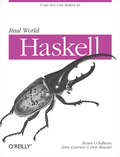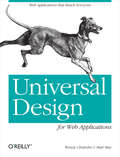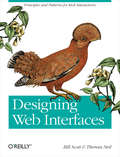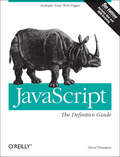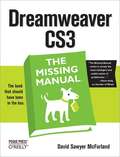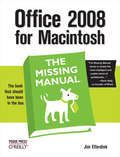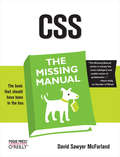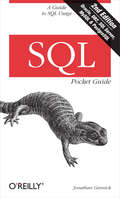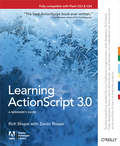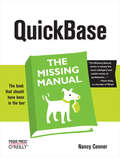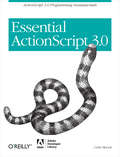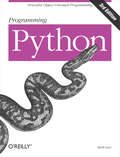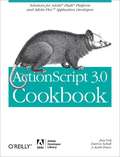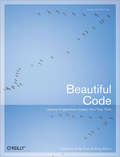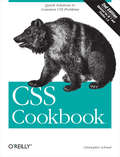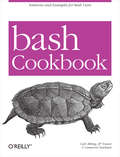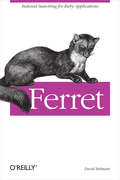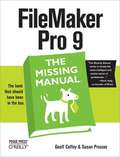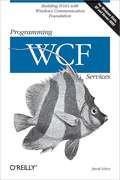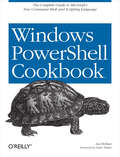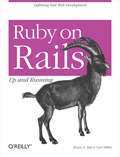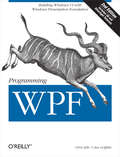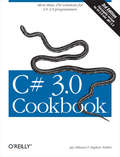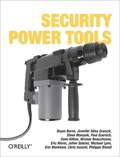- Table View
- List View
Real World Haskell
by Donald Bruce Stewart John Goerzen Bryan O'SullivanThis easy-to-use, fast-moving tutorial introduces you to functional programming with Haskell. You'll learn how to use Haskell in a variety of practical ways, from short scripts to large and demanding applications. Real World Haskell takes you through the basics of functional programming at a brisk pace, and then helps you increase your understanding of Haskell in real-world issues like I/O, performance, dealing with data, concurrency, and more as you move through each chapter. With this book, you will: Understand the differences between procedural and functional programming Learn the features of Haskell, and how to use it to develop useful programs Interact with filesystems, databases, and network services Write solid code with automated tests, code coverage, and error handling Harness the power of multicore systems via concurrent and parallel programming You'll find plenty of hands-on exercises, along with examples of real Haskell programs that you can modify, compile, and run. Whether or not you've used a functional language before, if you want to understand why Haskell is coming into its own as a practical language in so many major organizations, Real World Haskell is the best place to start.
Universal Design for Web Applications
by Wendy Chisholm Matt MayUniversal Design for Web Applications teaches you how to build websites that are more accessible to people with disabilities and explains why doing so is good business. It takes more work up front, but the potential payoff is huge -- especially when mobile users need to access your sites. You'll discover how to use standards-based web technologies -- such as XHTML, CSS, and Ajax, along with video and Flash -- to develop applications for a wide range of users and a variety of devices, including the mobile Web. You'll also learn specifics about this target audience, especially the key over-50 age group, whose use of the Web is rapidly growing. With this book, you will: Learn the importance of metadata and how it affects images, headings, and other design elements Build forms that accommodate cell phones, screen readers, word prediction, and more Create designs using color and text that are effective in a variety of situations Construct tables that present information without spatial cues Design Ajax-driven social networking applications that people with disabilities can access Provide audio with transcriptions and video that includes captions and audio descriptions Discover assistive technology support for Rich Internet Application technologies such as Flash, Flex, and Silverlight Universal Design for Web Applications provides you with a roadmap to help you design easy-to-maintain web applications that benefit a larger audience.
Beautiful Architecture
by Georgios Gousios Diomidis SpinellisWhat are the ingredients of robust, elegant, flexible, and maintainable software architecture? Beautiful Architecture answers this question through a collection of intriguing essays from more than a dozen of today's leading software designers and architects. In each essay, contributors present a notable software architecture, and analyze what makes it innovative and ideal for its purpose. Some of the engineers in this book reveal how they developed a specific project, including decisions they faced and tradeoffs they made. Others take a step back to investigate how certain architectural aspects have influenced computing as a whole. With this book, you'll discover: How Facebook's architecture is the basis for a data-centric application ecosystem The effect of Xen's well-designed architecture on the way operating systems evolve How community processes within the KDE project help software architectures evolve from rough sketches to beautiful systems How creeping featurism has helped GNU Emacs gain unanticipated functionality The magic behind the Jikes RVM self-optimizable, self-hosting runtime Design choices and building blocks that made Tandem the choice platform in high-availability environments for over two decades Differences and similarities between object-oriented and functional architectural views How architectures can affect the software's evolution and the developers' engagement Go behind the scenes to learn what it takes to design elegant software architecture, and how it can shape the way you approach your own projects, with Beautiful Architecture.
Designing Web Interfaces
by Bill Scott Theresa NeilWant to learn how to create great user experiences on today's Web? In this book, UI experts Bill Scott and Theresa Neil present more than 75 design patterns for building web interfaces that provide rich interaction. Distilled from the authors' years of experience at Sabre, Yahoo!, and Netflix, these best practices are grouped into six key principles to help you take advantage of the web technologies available today. With an entire section devoted to each design principle, Designing Web Interfaces helps you: Make It Direct-Edit content in context with design patterns for In Page Editing, Drag & Drop, and Direct Selection Keep It Lightweight-Reduce the effort required to interact with a site by using In Context Tools to leave a "light footprint" Stay on the Page-Keep visitors on a page with overlays, inlays, dynamic content, and in-page flow patterns Provide an Invitation-Help visitors discover site features with invitations that cue them to the next level of interaction Use Transitions-Learn when, why, and how to use animations, cinematic effects, and other transitions React Immediately-Provide a rich experience by using lively responses such as Live Search, Live Suggest, Live Previews, and more Designing Web Interfaces illustrates many patterns with examples from working websites. If you need to build or renovate a website to be truly interactive, this book gives you the principles for success.
JavaScript: The Definitive Guide
by David FlanaganThis Fifth Edition is completely revised and expanded to cover JavaScript as it is used in today's Web 2.0 applications. This book is both an example-driven programmer's guide and a keep-on-your-desk reference, with new chapters that explain everything you need to know to get the most out of JavaScript, including: Scripted HTTP and AjaxXML processingClient-side graphics using the canvas tagNamespaces in JavaScript--essential when writing complex programsClasses, closures, persistence, Flash, and JavaScript embedded in Java applicationsPart I explains the core JavaScript language in detail. If you are new to JavaScript, it will teach you the language. If you are already a JavaScript programmer, Part I will sharpen your skills and deepen your understanding of the language.Part II explains the scripting environment provided by web browsers, with a focus on DOM scripting with unobtrusive JavaScript. The broad and deep coverage of client-side JavaScript is illustrated with many sophisticated examples that demonstrate how to:Generate a table of contents for an HTML documentDisplay DHTML animationsAutomate form validationDraw dynamic pie chartsMake HTML elements draggableDefine keyboard shortcuts for web applicationsCreate Ajax-enabled tool tipsUse XPath and XSLT on XML documents loaded with AjaxAnd much morePart III is a complete reference for core JavaScript. It documents every class, object, constructor, method, function, property, and constant defined by JavaScript 1.5 and ECMAScript Version 3.Part IV is a reference for client-side JavaScript, covering legacy web browser APIs, the standard Level 2 DOM API, and emerging standards such as the XMLHttpRequest object and the canvas tag.More than 300,000 JavaScript programmers around the world have madethis their indispensable reference book for building JavaScript applications."A must-have reference for expert JavaScript programmers...well-organized and detailed."-- Brendan Eich, creator of JavaScript
Dreamweaver CS3: The Missing Manual
by David Sawyer McfarlandWelcome to Dreamweaver CS3. This new version of the popular web design software offers a rich environment for building professional sites, with drag-and-drop simplicity, clean HTML code, and dynamic database-driven web site creation tools. Moreover, it's now integrated more tightly with Adobe's other products: Photoshop, InDesign, Flash, and their siblings. But with such sophisticated features, the software isn't simple.So say hello to Dreamweaver CS3: The Missing Manual, the fifth edition of this bestselling book by experienced web site trainer and author David McFarland. This book helps both first-time and experienced web designers bring stunning, interactive web sites to life. With jargon-free language and clear descriptions, this new edition addresses both beginners who need step-by-step guidance as well as long-time Dreamweaver users who need a handy reference to address the inner-workings of the program.Dreamweaver CS3: The Missing Manual teaches designers how to construct and manage web sites by examining web-page components and Dreamweaver's capabilities through "live examples". With a complete A-Z guide to designing, organizing, building and deploying a web site for those with no web design experience, this book:Takes you through the basics to advanced techniques to control the appearance of your web pages with CSSShows you how to design dynamic database-driven web sites, from blogs to product catalogs, and from shopping carts to newsletter signup formsTeaches you how to master your web site, and manage thousands of pages effortlesslyWitty and objective, Dreamweaver CS3: The Missing Manual is a must for anyone who uses this highly popular program, from beginners to professionals. Altogether, it's the ultimate atlas for Dreamweaver CS3.
Office 2008 for Macintosh: The Missing Manual
by Jim ElferdinkStill the top-selling software suite for Mac users, Microsoft Office has been improved and enhanced to take advantage of the latest Mac OS X features. You'll find lots of new features in Office 2008 for Word, Excel, PowerPoint and Entourage, but not a page of printed instructions to guide you through the changes. Office 2008 for Macintosh: The Missing Manual gives you the friendly, thorough introduction you need, whether you're a beginner who can't do more than point and click, or a power user who's ready to tackle a few advanced techniques. To cover Word, Excel, PowerPoint and Entourage, this guide gives you four superb books in one -- a separate section each for program! You can manage your day and create professional-looking documents, spreadsheets, and presentations in no time. Office 2008 has been redesigned so that the windows, toolbars, and icons blend in better with your other Mac applications. But there are still plenty of oddities. That's why this Missing Manual isn't shy about pointing out which features are gems in the rough -- and which are duds. With it, you'll learn how to: Navigate the new user interface with its bigger and more graphic toolbars Use Word, Excel, PowerPoint, and Entourage separately or together Keep track of appointments and manage daily priorities with the My Day feature Create newsletters, flyers, brochures, and more with Word's Publishing Layout View Build financial documents like budgets and invoices with Excel's Ledger Sheets Get quick access to all document templates and graphics with the Elements Gallery Organize all of your Office projects using Entourage's Project Center Scan or import digital camera images directly into any of the programs Customize each program with power-user techniques With Office 2008 for Macintosh: The Missing Manual, you get objective and entertaining instruction to help you tap into all of the features of this powerful suite, so you can get more done in less time.
CSS: The Missing Manual
by David Sawyer McfarlandWeb site design has grown up. Unlike the old days, when designers cobbled togetherchunky HTML, bandwidth-hogging graphics, and a prayer to make their sites look good,Cascading Style Sheets (CSS) now lets your inner designer come out and play. But CSSisn't just a tool to pretty up your site; it's a reliable method for handling allkinds of presentation--from fonts and colors to page layout. CSS: The MissingManual clearly explains this powerful design language and how you can use it tobuild sparklingly new Web sites or refurbish old sites that are ready for an upgrade.Like their counterparts in print page-layout programs, style sheets allowdesigners to apply typographic styles, graphic enhancements, and precise layoutinstructions to elements on a Web page. Unfortunately, due to CSS's complexity andthe many challenges of building pages that work in all Web browsers, most Web authorstreat CSS as a kind of window-dressing to spruce up the appearance of their sites.Integrating CSS with a site's underlying HTML is hard work, and often frustratinglycomplicated. As a result many of the most powerful features of CSS are left untapped.With this book, beginners and Web-building veterans alike can learn how to navigatethe ins-and-outs of CSS and take complete control over their Web pages'appearance.Author David McFarland (the bestselling author of O'Reilly's Dreamweaver: TheMissing Manual) combines crystal-clear explanations, real-world examples, a dashof humor, and dozens of step-by-step tutorials to show you ways to design sites withCSS that work consistently across browsers. You'll learn how to:Create HTML that's simpler, uses less code, is search-engine friendly, andworks well with CSSStyle text by changing fonts, colors, font sizes, and adding bordersTurn simple HTML links into complex and attractive navigation bars-completewith CSS-only rollover effects that add interactivity to your Web pagesStyle images to create effective photo galleries and special effects likeCSS-based drop shadowsMake HTML forms look great without a lot of messy HTMLOvercome the most hair-pulling browser bugs so your Web pages work consistentlyfrom browser to browserCreate complex layouts using CSS, including multi-column designs that don'trequire using old techniques like HTML tablesStyle Web pages for printingUnlike competing books, this Missing Manual doesn't assume that everyone in theworld only surfs the Web with Microsoft's Internet Explorer; our book providessupport for all major Web browsers and is one of the first books to thoroughlydocument the newly expanded CSS support in IE7, currently in beta release.Want to learn how to turn humdrum Web sites into destinations that will captureviewers and keep them longer? Pick up CSS: The Missing Manual and learn thereal magic of this tool.
SQL Pocket Guide
by Jonathan GennickSQL is the language of databases. It's used to create and maintain database objects, place data into those objects, query the data, modify the data, and, finally, delete data that is no longer needed. Databases lie at the heart of many, if not most business applications. Chances are very good that if you're involved with software development, you're using SQL to some degree. And if you're using SQL, you should own a good reference or two. Now available in an updated second edition, our very popular SQL Pocket Guide is a major help to programmers, database administrators, and everyone who uses SQL in their day-to-day work. The SQL Pocket Guide is a concise reference to frequently used SQL statements and commonly used SQL functions. Not just an endless collection of syntax diagrams, this portable guide addresses the language's complexity head on and leads by example. The information in this edition has been updated to reflect the latest versions of the most commonly used SQL variants including:Oracle Database 10g, Release 2 (includingthe free Oracle Database 10g Express Edition (XE))Microsoft SQL Server 2005MySQL 5IBM DB2 8.2PostreSQL 8.1 database
Learning ActionScript 3.0: The Non-Programmer's Guide to ActionScript 3.0
by Rich Shupe Zevan RosserIn this book, authors Rich Shupe and Zevan Rosser share the knowledge they've gained from their years as multimedia developers/designers and teachers. Learning ActionScript 3.0 gives you a solid foundation in the language of Flash and demonstrates how you can use it for practical, everyday projects.The authors do more than just give you a collection of sample scripts. Written for those of you new to ActionScript 3.0, the book describes how ActionScript and Flash work, giving you a clear look into essential topics such as logic, event handling, displaying content, migrating legacy projects to ActionScript 3.0, classes, and much more. You will learn important techniques through hands-on exercises, and then build on those skills as chapters progress.ActionScript 3.0 represents a significant change for many Flash users, and a steeper learning curve for the uninitiated. This book will help guide you through a variety of scripting scenarios. Rather than relying heavily on prior knowledge of object-oriented programming (OOP), topics are explained in focused examples that originate in the timeline, with optional companion classes for those already comfortable with their use. As chapters progress, the book introduces more and more OOP techniques, allowing you to choose which scripting approach you prefer.Learning ActionScript 3.0 reveals:New ways to harness the power and performance of AS3Common mistakes that people make with the languageEssential coverage of text, sound, video, XML, drawing with code, and moreMigration issues from AS1 and AS2 to AS3Simultaneous development of procedural and object-oriented techniquesTips that go beyond simple script collections, including how to approach a project and which resources can help you along the wayThe companion web site contains material for all the exercises in the book, as well as short quizzes to make sure you're up to speed with key concepts. ActionScript 3.0 is a different animal from previous versions, and Learning ActionScript 3.0 teaches everything that web designers, GUI-based Flash developers, and those new to ActionScript need to start using the language.
QuickBase: The Missing Manual
by Nancy ConnerReady to put Intuit's QuickBase to work? Our new Missing Manual shows you how to capture, modify, share, and manage data and documents with this web-based data-sharing program quickly and easily. No longer do you have to coordinate your team through a blizzard of emails or play frustrating games of "guess which document is the right one." QuickBase saves your organization time and money, letting you manage and share the information that makes your business tick: sales figures, project timelines, drafts of documents, purchase or work requests--whatever information you need to keep business flowing smoothly. QuickBase: The Missing Manual shows you how to choose among QuickBase's dozens of ready-made applications (mini-databases, essentially) and how to customize one to fit your needs exactly. You'll also learn to assign people different roles within the application. The guide also shows you how to:Capture and modify data: Whatever kind of data you need to store--sales leads, catalog listings, project milestones, workflow checklists--you can use QuickBase's forms to record and organize that data so it makes sense to you. Filter, sort, and group data: Easily find the records that match your criteria, and then sort those records into groups that make their relationships clear. Display your data: QuickBase uses different views (Table, Grid Edit, Summary/Crosstab, Calendar, Chart, and Timeline) to display and summarize data. Switching between them is easy, like taking tasks listed in a table and displaying them as a timeline. Create reports: Print out a hard copy, embed charts in the annual report, or email this month's sales numbers. Because Intuit frequently introduces new features to QuickBase, you'll find updates to this book at our Missing Manual web site so you can benefit from the latest technology and user suggestions right away.
Essential ActionScript 3.0
by Colin MoockActionScript 3.0 is a huge upgrade to Flash's programming language. The enhancements to ActionScript's performance, feature set, ease of use, cleanliness, and sophistication are considerable. Essential ActionScript 3.0 focuses on the core language and object-oriented programming, along with the Flash Player API. Essential ActionScript has become the #1 resource for the Flash and ActionScript development community, and the reason is the author, Colin Moock. Many people even refer to it simply as "The Colin Moock book." And for good reason: No one is better at turning ActionScript inside out, learning its nuances and capabilities, and then explaining everything in such an accessible way. Colin Moock is not just a talented programmer and technologist; he's also a gifted teacher. Essential ActionScript 3.0 is a radically overhauled update to Essential ActionScript 2.0. True to its roots, the book once again focuses on the core language and object-oriented programming, but also adds a deep look at the centerpiece of Flash Player's new API: display programming. Enjoy hundreds of brand new pages covering exciting new language features, such as the DOM-based event architecture, E4X, and namespaces--all brimming with real-world sample code. The ActionScript 3.0 revolution is here, and Essential ActionScript 3.0's steady hand is waiting to guide you through it. Adobe Developer Library is a co-publishing partnership between O'Reilly Media and Adobe Systems, Inc. and is designed to produce the number one information resources for developers who use Adobe technologies. Created in 2006, the Adobe Developer Library is the official source for comprehensive learning solutions to help developers create expressive and interactive web applications that can reach virtually anyone on any platform. With top-notch books and innovative online resources covering the latest in rich Internet application development, the Adobe Developer Library offers expert training and in-depth resources, straight from the source.
Programming Python 3rd Edition
by Mark LutzIf you've mastered Python's fundamentals, you're ready to start using it to get real work done. Programming Python will show you how, with in-depth tutorials on the language's primary application domains: system administration, GUIs, and the Web. You'll also explore how Python is used in databases, networking, front-end scripting layers, text processing, and more. This book focuses on commonly used tools and libraries to give you a comprehensive understanding of Python's many roles in practical, real-world programming. You'll learn language syntax and programming techniques in a clear and concise manner, with lots of examples that illustrate both correct usage and common idioms. Completely updated for version 3.x, Programming Python also delves into the language as a software development tool, with many code examples scaled specifically for that purpose. Topics include: Quick Python tour: Build a simple demo that includes data representation, object-oriented programming, object persistence, GUIs, and website basics System programming: Explore system interface tools and techniques for command-line scripting, processing files and folders, running programs in parallel, and more GUI programming: Learn to use Python's tkinter widget library Internet programming: Access client-side network protocols and email tools, use CGI scripts, and learn website implementation techniques More ways to apply Python: Implement data structures, parse text-based information, interface with databases, and extend and embed Python
ActionScript 3.0 Cookbook
by Joey Lott Darron Schall Keith PetersWell before Ajax and Microsoft's Windows Presentation Foundation hit the scene, Macromedia offered the first method for building web pages with the responsiveness and functionality of desktop programs with its Flash-based "Rich Internet Applications". Now, new owner Adobe is taking Flash and its powerful capabilities beyond the Web and making it a full-fledged development environment. Rather than focus on theory, the ActionScript 3.0 Cookbook concentrates on the practical application of ActionScript, with more than 300 solutions you can use to solve a wide range of common coding dilemmas. You'll find recipes that show you how to: Detect the user's Flash Player version or their operating system Build custom classes Format dates and currency types Work with strings Build user interface components Work with audio and video Make remote procedure calls using Flash Remoting and web services Load, send, and search XML data And much, much more ... Each code recipe presents the Problem, Solution, and Discussion of how you can use it in other ways or personalize it for your own needs, and why it works. You can quickly locate the recipe that most closely matches your situation and get the solution without reading the whole book to understand the underlying code. Solutions progress from short recipes for small problems to more complex scripts for thornier riddles, and the discussions offer a deeper analysis for resolving similar issues in the future, along with possible design choices and ramifications. You'll even learn how to link modular ActionScript pieces together to create rock-solid solutions for Flex 2 and Flash applications. When you're not sure how ActionScript 3.0 works or how to approach a specific programming dilemma, you can simply pick up the book, flip to the relevant recipe(s), and quickly find the solution you're looking for. Adobe Developer Library is a co-publishing partnership between O'Reilly Media and Adobe Systems, Inc. and is designed to produce the number one information resources for developers who use Adobe technologies. Created in 2006, the Adobe Developer Library is the official source for comprehensive learning solutions to help developers create expressive and interactive web applications that can reach virtually anyone on any platform. With top-notch books and innovative online resources covering the latest in rich Internet application development, the Adobe Developer Library offers expert training and in-depth resources, straight from the source.
Beautiful Code: Leading Programmers Explain How They Think
by Andy Oram Greg WilsonHow do the experts solve difficult problems in software development? In this unique and insightful book, leading computer scientists offer case studies that reveal how they found unusual, carefully designed solutions to high-profile projects. You will be able to look over the shoulder of major coding and design experts to see problems through their eyes. This is not simply another design patterns book, or another software engineering treatise on the right and wrong way to do things. The authors think aloud as they work through their project's architecture, the tradeoffs made in its construction, and when it was important to break rules. This book contains 33 chapters contributed by Brian Kernighan, Karl Fogel, Jon Bentley, Tim Bray, Elliotte Rusty Harold, Michael Feathers, Alberto Savoia, Charles Petzold, Douglas Crockford, Henry S. Warren, Jr., Ashish Gulhati, Lincoln Stein, Jim Kent, Jack Dongarra and Piotr Luszczek, Adam Kolawa, Greg Kroah-Hartman, Diomidis Spinellis, Andrew Kuchling, Travis E. Oliphant, Ronald Mak, Rogerio Atem de Carvalho and Rafael Monnerat, Bryan Cantrill, Jeff Dean and Sanjay Ghemawat, Simon Peyton Jones, Kent Dybvig, William Otte and Douglas C. Schmidt, Andrew Patzer, Andreas Zeller, Yukihiro Matsumoto, Arun Mehta, TV Raman, Laura Wingerd and Christopher Seiwald, and Brian Hayes. Beautiful Code is an opportunity for master coders to tell their story. All author royalties will be donated to Amnesty International.
CSS Cookbook
by Christopher SchmittAs the industry standard method for enriching the presentation of HTML-based web pages, Cascading Style Sheets (CSS) allow you to give web pages more structure and a more sophisticated look. But first, you have to get past CSS theory and resolve real-world problems. For those all-too-common dilemmas that crop up with each project, CSS Cookbook provides hundreds of practical examples with CSS code recipes that you can use immediately to format your web pages. Arranged in a quick-lookup format for easy reference, the second edition has been updated to explain the unique behavior of the latest browsers: Microsoft's IE 7 and Mozilla's Firefox 1.5. Also, the book has been expanded to cover the interaction of CSS and images and now includes more recipes for beginning CSS users. The explanation that accompanies each recipe enables you to customize the formatting for your specific needs. With topics that range from basic web typography and page layout to techniques for formatting lists, forms, and tables, this book is a must-have companion, regardless of your experience with Cascading Style Sheets.
bash Cookbook
by Carl Albing Jp Vossen Cameron NewhamThe key to mastering any Unix system, especially Linux and Mac OS X, is a thorough knowledge of shell scripting. Scripting is a way to harness and customize the power of any Unix system, and it's an essential skill for any Unix users, including system administrators and professional OS X developers. But beneath this simple promise lies a treacherous ocean of variations in Unix commands and standards. bash Cookbook teaches shell scripting the way Unix masters practice the craft. It presents a variety of recipes and tricks for all levels of shell programmers so that anyone can become a proficient user of the most common Unix shell -- the bash shell -- and cygwin or other popular Unix emulation packages. Packed full of useful scripts, along with examples that explain how to create better scripts, this new cookbook gives professionals and power users everything they need to automate routine tasks and enable them to truly manage their systems -- rather than have their systems manage them.
Ferret
by David BalmainWith the introduction of Ferret, Ruby users now have one of the fastest and most flexible search libraries available. And it's surprisingly easy to use. This book will show you how to quickly get up and running with Ferret. You'll learn how to index different document types such as PDF, Microsoft Word, and HTML, as well as how to deal with foreign languages and different character encodings. Ferret describes the Ferret Query Language in detail along with the object-oriented approach to building queries. You will also be introduced to sorting, filtering, and highlighting your search results, with an explanation of exactly how you need to set up your index to perform these tasks. You will also learn how to optimize a Ferret index for lightning fast indexing and split-second query results.
FileMaker Pro 9: The Missing Manual
by Geoff Coffey Susan ProsserFileMaker Pro 9: The Missing Manual is the clear, thorough and accessible guide to the latest version of this popular desktop database program. FileMaker Pro lets you do almost anything with the information you give it. You can print corporate reports, plan your retirement, or run a small country -- if you know what you're doing. This book helps non-technical folks like you get in, get your database built, and get the results you need. Pronto. The new edition gives novices and experienced users the scoop on versions 8.5 and 9. It offers complete coverage of timesaving new features such as the Quick Start screen that lets you open or a create a database in a snap, the handy "save to" buttons for making Excel documents or PDFs, the multiple level Undo and Redo commands let you step backwards through your typing tasks, and much more. With FileMaker Pro 9: The Missing Manual, you can: Get your first database running in minutes and perform basic tasks right away. Catalog people, processes and things with streamlined data entry and sorting tools. Learn to use layout tools to organize the appearance of your database. Use your data to generate reports, correspondence and other documents with ease. Create, connect, and manage multiple tables and set up complex relationships that show you just the data you need. Crunch numbers, search text, or pin down dates and times with dozens of built-in formulas. Automate repetitive tasks with FileMaker Pro 9's easy-to-learn scripting language. Protect your database with passwords and set up privileges to determine what others can do once they gain entry. Outfit your database for the Web and import and export data to other formats. Each chapter in the book contains "living examples" -- downloadable tutorials that help you learn how to build a database by actually doing it. You also get plenty of sound, objective advice that lets you know which features are really useful, and which ones you'll barely touch. To make the most of FileMaker Pro 9, you need the book that should have been in the box.
Programming WCF Services
by Juval LowyWritten by Microsoft software legend Juval Lowy, Programming WCF Services is the authoritative introduction to Microsoft's new, and some say revolutionary, unified platform for developing service-oriented applications (SOA) on Windows. Relentlessly practical, the book delivers insight, not documentation, to teach developers what they need to know to build the next generation of SOAs. After explaining the advantages of service-orientation for application design and teaching the basics of how to develop SOAs using WCF, the book shows how you can take advantage of built-in features such as service hosting, instance management, asynchronous calls, synchronization, reliability, transaction management, disconnected queued calls and security to build best in class applications. Programming WCF Services focuses on the rationale behind particular design decisions, often shedding light on poorly-documented and little-understood aspects of SOA development. Developers and architects will learn not only the "how" of WCF programming, but also relevant design guidelines, best practices, and pitfalls. Original techniques and utilities provided by the author throughout the book go well beyond anything that can be found in conventional sources. Based on experience and insight gained while taking part in the strategic design of WCF and working with the team that implemented it, Programming WCF Services provides experienced working professionals with the definitive work on WCF. Not only will this book make you a WCF expert, it will make you a better software engineer. It's the Rosetta Stone of WCF.
Windows PowerShell Cookbook: for Windows, Exchange 2007, and MOM V3
by Lee HolmesThis Cookbook by Windows PowerShell team developer Lee Holmes provides hundreds of tested scripts that you can use right away to get Microsoft's new tool working for you. More than 150 recipes, combined with a concise task-based introduction to the Windows PowerShell scripting language and environment, make it the perfect look-up guide when you encounter a thorny problem, or need a quick solution. The ideal companion to any tutorial or reference, this book meets the needs of system administrators at any level.Microsoft has revolutionized the world of system management and command-line shells with its release of Windows PowerShell, and Lee Holmes gives you practical tools and inside advice that will make you a more productive user and administrator. You will be able to solve everything from automating routine tasks, working with files, event logs and other forms of structured data, to managing the users and resources of complex Windows networks. Each recipe includes a focused piece of code plus discussion of how and why it works, so that you can apply the solution to similar tasks.You get an array of recipes covering PowerShell fundamentals, common tasks, and administrator tasks, including:Pipelines, variables, objects, looping and flow control, strings and unstructured text, calculations and mathSimple files; structured files; Internet-enabled scripts; code reuse; lists, arrays and hashtables; user feedback; error management; environmental awareness; script signing; and moreFiles and directories, registry manipulation, comparing data, event logs, process cmdlets, service cmdlets, Active Directory, enterprise computer management, and moreThose who administer Microsoft's Exchange 2007 and System Center Operations Manager (formerly MOM) will also benefit from this book, with separate chapters devoted to these servers. All Windows administrators will appreciate the appendices that include a PowerShell language quick reference, and a reference to the .NET, WMI and COM objects that PowerShell scripters will use often.With working scripts, tutorials, and references all in one volume, Windows PowerShell Cookbook will turbocharge the productivity of any Windows administrator.
Ruby on Rails: Up and Running
by Curt Hibbs Bruce A. TateRuby on Rails is the super-productive new way to develop full-featured web applications. With Ruby on Rails, powerful web applications that once took weeks or months to develop can now be produced in a matter of days. If it sounds too good to be true, it isn't. If you're like a lot of web developers, you've probably considered kicking the tires on Rails - the framework of choice for the new generation of Web 2.0 developers. Ruby on Rails: Up and Running takes you out for a test drive and shows you just how fast Ruby on Rails can go. This compact guide teaches you the basics of installing and using both the Ruby scripting language and the Rails framework for the quick development of web applications. Ruby on Rails: Up and Running covers just about everything you need - from making a simple database-backed application to adding elaborate Ajaxian features and all the juicy bits in between. While Rails is praised for its simplicity and speed of development, there are still a few steps to master on the way. More advanced material helps you map data to an imperfect table, traverse complex relationships, and build custom finders. A section on working with Ajax and REST shows you how to exploit the Rails service frameworks to send emails, implement web services, and create dynamic user-centric web pages. The book also explains the essentials of logging to find performance problems and delves into other performance-optimizing techniques. As new web development frameworks go, Ruby on Rails is the talk of the town. And Ruby on Rails: Up and Running can make sure you're in on the discussion.
Programming WPF
by Chris Sells Ian GriffithsIf you want to build applications that take full advantage of Windows Vista's new user interface capabilities, you need to learn Microsoft's Windows Presentation Foundation (WPF). This new edition, fully updated for the official release of .NET 3.0, is designed to get you up to speed on this technology quickly. By page 2, you'll be writing a simple WPF application. By the end of Chapter 1, you'll have taken a complete tour of WPF and its major elements. WPF is the new presentation framework for Windows Vista that also works with Windows XP. It's a cornucopia of new technologies, which includes a new graphics engine that supports 3-D graphics, animation, and more; an XML-based markup language, called XAML, for declaring the structure of your Windows UI; and a radical new model for controls. This second edition includes new chapters on printing, XPS, 3-D, navigation, text and documents, along with a new appendix that covers Microsoft's new WPF/E platform for delivering richer UI through standard web browsers -- much like Adobe Flash. Content from the first edition has been significantly expanded and modified. Programming WPF includes: Scores of C# and XAML examples that show you what it takes to get a WPF application up and running, from a simple "Hello, Avalon" program to a tic-tac-toe game Insightful discussions of the powerful new programming styles that WPF brings to Windows development, especially its new model for controls A color insert to better illustrate WPF support for 3-D, color, and other graphics effects A tutorial on XAML, the new HTML-like markup language for declaring Windows UI An explanation and comparison of the features that support interoperability with Windows Forms and other Windows legacy applicationsWPF represents the best of the control-based Windows world and the content-based web world. Programming WPF helps you bring it all together.
C# 3.0 Cookbook: More Than 250 solutions for C# 3.0 Programmers
by Jay Hilyard Stephen TeilhetCompletely updated for C# 3.0 and the .NET 3.5 platform, the new edition of this bestseller offers more than 250 code recipes to common and not-so-common problems that C# programmers face every day. Every recipe in the book has been reconsidered with more than a third of them rewritten to take advantage of new C# 3.0 features. If you prefer solutions you can use today to general C# language instruction, and quick answers to theory, this is your book.C# 3.0 Cookbook offers a new chapter on LINQ (language integrated query), plus two expanded chapters for recipes for extension methods, lambda functions, object initializers, new synchronization primitives and more. The new edition is also complemented by a public wiki, which not only includes all of the C# 2.0 recipes from the previous edition unchanged by the release of C# 3.0, but invites you to suggest better ways to solve those tasks.Here are some of topics covered:LINQNumeric data types and EnumerationsStrings and charactersClasses and structuresGenericsCollectionsException handlingDelegates, events, and lambda expressionsFilesystem interactionsWeb site accessXML usage (including LINQ to XML, XPath and XSLT)NetworkingThreadingData Structures & AlgorithmsEach recipe in the book includes tested code that you can download from oreilly.com and reuse in your own applications, and each one includes a detailed discussion of how and why the underling technology works. You don't have to be an experienced C# or .NET developer to use C# 3.0 Cookbook. You just have to be someone who wants to solve a problem now, without having to learn all the related theory first.
Security Power Tools
by Jennifer Stisa Granick Eric Moret Bryan Burns Eric Markham Dave Killion Julien Sobrier Chris Iezzoni Nicolas Beauchesne Michael Lynn Paul Guersch Steve Manzuik Philippe BiondiWhat if you could sit down with some of the most talented security engineers in the world and ask any network security question you wanted? Security Power Tools lets you do exactly that! Members of Juniper Networks' Security Engineering team and a few guest experts reveal how to use, tweak, and push the most popular network security applications, utilities, and tools available using Windows, Linux, Mac OS X, and Unix platforms. Designed to be browsed, Security Power Tools offers you multiple approaches to network security via 23 cross-referenced chapters that review the best security tools on the planet for both black hat techniques and white hat defense tactics. It's a must-have reference for network administrators, engineers and consultants with tips, tricks, and how-to advice for an assortment of freeware and commercial tools, ranging from intermediate level command-line operations to advanced programming of self-hiding exploits. Security Power Tools details best practices for: Reconnaissance -- including tools for network scanning such as nmap; vulnerability scanning tools for Windows and Linux; LAN reconnaissance; tools to help with wireless reconnaissance; and custom packet generation Penetration -- such as the Metasploit framework for automated penetration of remote computers; tools to find wireless networks; exploitation framework applications; and tricks and tools to manipulate shellcodes Control -- including the configuration of several tools for use as backdoors; and a review of known rootkits for Windows and Linux Defense -- including host-based firewalls; host hardening for Windows and Linux networks; communication security with ssh; email security and anti-malware; and device security testing Monitoring -- such as tools to capture, and analyze packets; network monitoring with Honeyd and snort; and host monitoring of production servers for file changes Discovery -- including The Forensic Toolkit, SysInternals and other popular forensic tools; application fuzzer and fuzzing techniques; and the art of binary reverse engineering using tools like Interactive Disassembler and Ollydbg A practical and timely network security ethics chapter written by a Stanford University professor of law completes the suite of topics and makes this book a goldmine of security information. Save yourself a ton of headaches and be prepared for any network security dilemma with Security Power Tools.
